UCLA Football Offensive Preview
Another historic rivalry is coming to an end, but this time, Cal faces one of the teams responsible for the demise of the Pac-12 Conference.
The University of California, Southern Branch. The University of California at Los Angeles. UCLA. There are many names you might know it by, but you know it’s a poor offshoot of the original University of California.
However, you may be surprised to learn that’s not quite correct.
You see, UCLA was originally an offshoot of the California State Normal School (now known as San Jose State University). “Normal” in this context refers to the fact it was a school to train elementary school teachers (as opposed to the complete un-exceptionalism of the people who attend UCLA). While the University of California’s agricultural school (the “University Farm”) became UC Davis, the University of California’s affiliate medical school became UC San Francisco and its affiliate law school became the University of California, Hastings College of the Law (recently renamed to University of California College of the Law, San Francisco), it turns out that no one at the University of California even wanted the school now known as UCLA. Then-UC President Benjamin Ide Wheeler and the other UC regents were all vigorously opposed to the idea of a southern campus, but the the Los Angeles Normal School lobbied the state government (which signed Assembly Bill 626 into law in 1919) to force their way into the UC system as the Southern Branch of the University of California.
Unsurprisingly, UCLA knew then as they do now that the only way to improve their brand was to hitch their wagon to a brand name built by the hard work and effort of others. So is it really any surprise that in this era of conference realignment that these guys…
…would team up with House USC of Casterly Rock to screw over everyone else?
No one should be surprised by USC’s betrayal, nor that they care more for the almighty dollar than 100+ years of historic football rivalries. Sure, rivalries are what make the sport great, but how much is FOX paying again?
And that brings us to “Calimony,” a moniker too clever to have been penned by UCLA. And although clever, it completely misrepresents the situation. Don’t think for a moment that USC invited UCLA along with them to the Big Ten Conference out of the goodness of their hearts or to preserve their football rivalry or some other noble ideal. No, UCLA was the unwitting pawn in USC’s scheme to ensure the death of the Pacific Conference, not allowing any other rival conferences to gain a foothold in the Los Angeles TV market, which is the only reason UCLA football has any value whatsoever (the same reason Rutgers has any value to the Big Ten, thanks to their access to the NY/NJ TV markets). Despite being part of the larger UC system, they worked in secret to screw over that system in a shortsighted attempt to enrich themselves at the expense of the university system that actually pays their bills.
UCLA could have stayed in the conference, granting the conference a continued foothold in the LA TV market and the Pac-11 likely could have found reasonable expansion candidates to survive this round of realignment, and everyone would have been better off.
And this is why I find the “Calimony” moniker inappropriate. Only UCLA could frame it this way, as if it were an equal payment between ex-spouses. When you steal money from your parents’ wallet (the literal UC system, in this case), and they make you pay it back, that’s not an alimony payment. That’s retribution for you being a little shit.
Both UC schools could have made more money with a better conference deal. If you increase your conference payout by $30M but cost your affiliated school $40M, you didn’t make $30M, you instead cost everyone $10M. It’s not a matter of fairness, it’s a matter of your school being a net drain on the university system to which it belongs. It’s not the UC system’s fault you lacked the foresight to evaluate the consequences of your actions.
As a Los Angeles native, I’ve never been too big of a fan of the LA schools. Sure, UCLA isn’t nearly as odious as USC, but that bar is so low that you can trip over it.
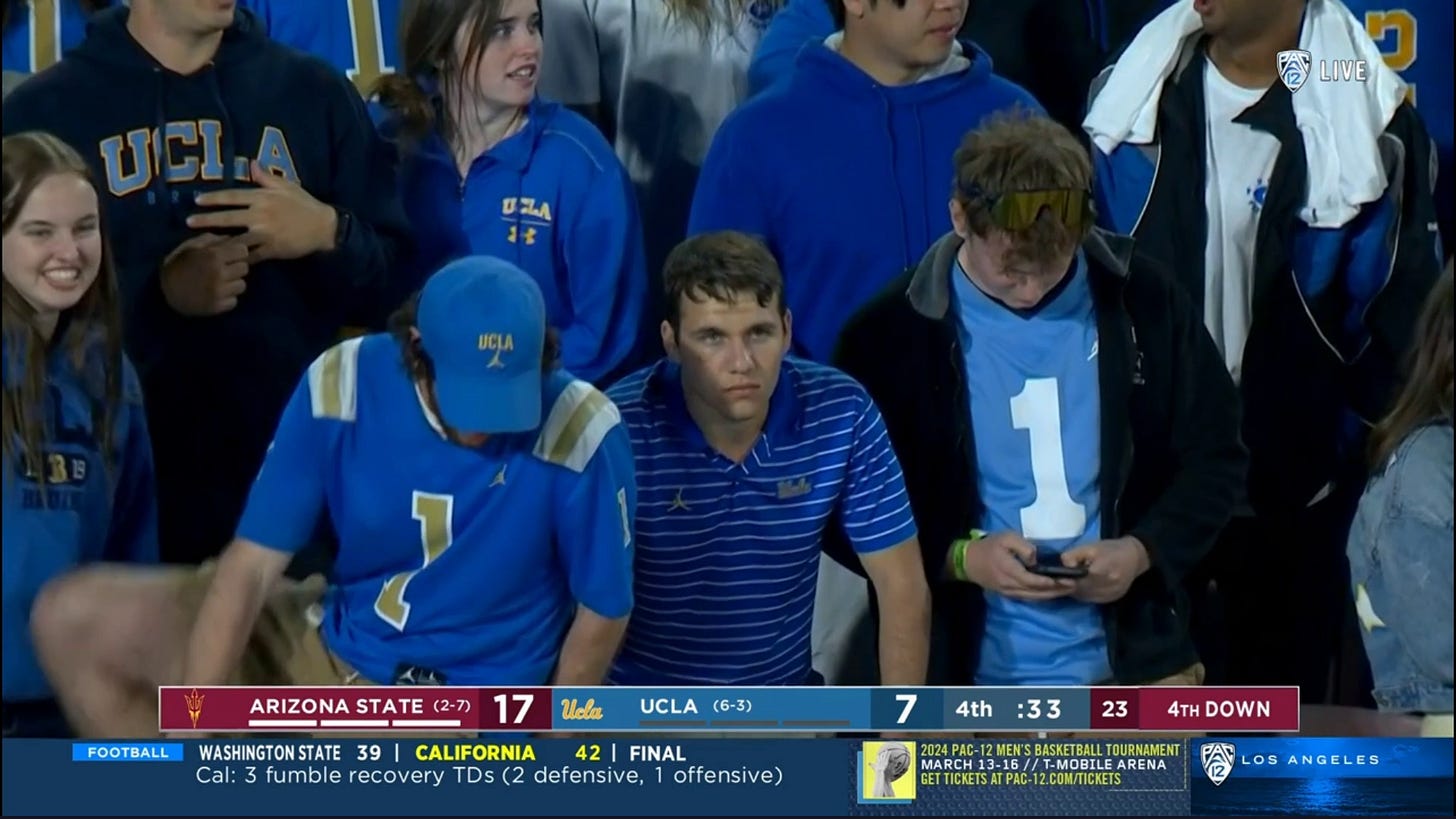
But it’s hard not to notice the recent trend of borrowing USC’s ethics to personally enrich themselves. Since this is supposed to be an article about football, let’s take a look at this quote by Washington State head coach Jake Dickert:
In completely and totally unrelated news, you may remember that UCLA siphoned off a couple of talented Cal players through the transfer portal. You may remember that former Cal linebacker Oluwafemi Oladejo announced his transfer to UCLA within hours of entering the transfer portal, with UCLA social media already having pre-made graphics ready to go with the announcement.
So we can be sure there was definitely no recruit tampering here, I’m just pointing out totally unrelated facts. You have to ask yourself, is UCLA too dumb to cover their tracks, or are they simply content intentionally flouting the rules? Seeing as we’re talking about UCLA, it’s easy to fathom some combination of both being true. Maybe they are right; maybe there is no use in adhering to NCAA rules.
UCLA never earned its alleged academic prestige; it had to hitch their wagon to the UC system to do so. And similarly, they certainly didn’t earn their newfound athletic prestige—their Big Ten membership—either. Deep down, of course, they know this to be true, which is why any UCLA fan is constantly overcompensating for their obvious inferiority complex. They’ll argue until they are blue in the face that according to this magazines recent ratings, this new ad-hoc metric shows that… blah blah blah. Anyone who has sat inside both a Berkeley classroom and a UCLA classroom knows the difference.
Enjoy being the new doormat of the Big Ten, UCLA. We won’t miss you.
Quarterback
UCLA’s quarterback situation this year was a mess. They brought in a highly-touted young quarterback recruit (the 5-star QB Dante Moore) and an experienced transfer quarterback (Kent State QB Collin Schlee), only to settle on the quarterback that has been there all along. I mean, can you imagine?
That quarterback is Ethan Garbers, younger brother of former Cal QB Chase Garbers. I was originally a fan of his: take my article from 2021, for instance, in which I mused “I actually think Ethan Garbers is going to be good. He's got a strong arm and good accuracy” or my article in 2022 in which I praised his mental toughness, “because he has to play with the knowledge that he is a constant disappointment to his parents after settling for such an inferior university”. Of course, as anyone can expect when attending UCLA, his development in college just hasn’t quite been there. It doesn’t help that Chip Kelly has used him as a backup option only these past 3 years, but through the process of elimination, he has established himself as the best passer on the team this year.
Garbers’s favorite target is WR Logan Loya, and he clearly has established chemistry with Loya (see Loya in the receivers section for more— by far Garbers’s favorite throw is to Loya on the short out route). Garbers is the only quarterback on the team that can hit timing routes, showing that he has at least some anticipation for how a play will develop:

Safety School Garbers doesn’t have quite the same wheels as his more talented brother, but he is able to scramble for first downs when left unaccounted for in the run game:
Here Garbers does a good job maneuvering the pocket to scramble against another bad defense:
Although I believe Bargain-Brand Garbers can read a defense, he’s not extremely confident in his reads and will sometimes be a beat late on his throws. Let’s take the following play, for instance, in which Kelly’s offense runs a Y-cross concept (something he was fond of during his time with the Ducks and the Eagles), a weakside flood to the left side of the field; there’s a smash concept on the left side of the field to put the corner and deep safety in a bind, and the Y-receiver comes across the formation to attack that zone (“flood”, meaning more receivers than defenders in that area) as well. You can see the two deep safeties bite outwards, leaving the Y-receiver (TE Moliki Matavao) wide open, but Garbers takes an extra hitch step and is late on the throw:

This is a great play call to attack this defense, but BOGO Garbers needs to throw this one earlier, as the late throw made the throwing window too small for him to hit. It’s the kind of play you can imagine a quarterback making if he were given more time in the offense to properly develop (quicker reads, trust your instincts, etc), but Garbers has only sporadically started during his time at UCLA and hence why I think his development has been stunted. This is a common theme for UCLA players, as you’ll see in a bit.
Here’s another example where Fire Sale Garbers has an open man and is unable to connect:
I think Garbers put too much air under the throw, but it’s also possible that he’s just not on the same page as his receiver, where Garbers is throwing to a spot but not the one that the receiver is expecting. Either way, it appears to be another chemistry issue, where the solution is just more playing time with his receivers. I think Goodwill Garbers has the tools, but UCLA just isn’t developing them.
UCLA isn’t able to rely on the running ability of their quarterbacks this year (after 7 straight years of Dorian Thompson-Robinson or whatever), and so they will have a designated running quarterback to run most of their RPO play concepts, the Kent State transfer Collin Schlee.
I think Chip Kelly is fond of some vintage formations like the wishbone or Wing-T and so on, so he will mix in some old-fashioned run-heavy concepts into the offense. Here Schlee keeps it himself, but note that the option pitch is there and it’s not uncommon for him to option it out, but the defender bites on the RB instead of Schlee, who is just as capable running the ball:
Schlee has a bit of speed and a willingness to make contact, so he has a bit of a hard-nosed running style:
Here Schlee again uses the threat of the option to pick up a first down:
And here’s that willingness to run through contact:
Although Schlee is still a quarterback and not purely a runner, UCLA uses him primarily in running situations, where you know UCLA is going to run the ball, but they don’t care that you know.
Backup quarterbacks
This section is about as useful as a UCLA degree so feel free to skip it, but I was forced to watch an entire season of bad UCLA offensive film and it would be a waste of my time to not cover it (this is known as the sunk cost fallacy, i.e. the same reason people even get UCLA degrees). So just read this section if you’re really curious what went wrong on offense for UCLA this year.
Let’s get Collin Schlee out of the way first. He’s not quite a “backup” quarterback and more of a situational/gadget-type player for UCLA, similar to the way Stanford likes to use QB Justin Lamson (typically, in obvious running situations). He did start one game this year due to injuries—meaning, he played like a regular quarterback—an ugly 17-7 loss to a bad ASU team. There were no obvious highlights or lowlights to include here (Schlee went 11/18 with 117 yards passing and 51 yards rushing), but there were just a lot of plays like this, where Schlee clearly doesn’t have the same level of chemistry with the receivers on e.g. timing routes:
In situations where he did throw the ball, I wasn’t particularly impressed. Even given a clean pocket, he still struggled with accuracy:
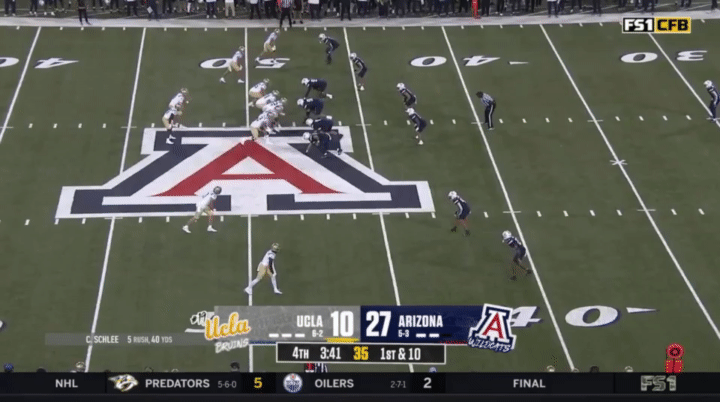
And here Schlee decides to pick on a future NFL first round corner, Colorado’s Travis Hunter, who baits Schlee into an interception:
This is a fantastic play by Hunter more than anything else, but you can see in the replay (sorry about the broadcast’s replay) that Hunter sinks his hips right as Schlee sets to throw, and Hunter reads his eyes to jump the route for the interception.
But the real question you probably have is: what about the 5-star QB Dante Moore, who reportedly nearly held out due to issues with his NIL payments before the season? You’re telling me UCLA has the #4 overall recruit in the class of 2023, and UCLA is benching him? You mean to tell me that UCLA recruited one of the most talented players available, and failed to develop him at all? Who could have seen this coming?
Just about the only throw that Dante Moore can reliably hit this year is a simple go-route down the sideline when it’s open (see the 62 yard catch by Sturdivant in the receivers section as an example). Moore seems to only have chemistry with Cal transfer WR J. Michael Sturdivant (to the detriment of Moore, who will lock onto Sturdivant and no one else), so I’d fathom a guess that these two have put in some extra reps together, and why Sturdivant’s production dropped off after Moore lost the starting job (Sturdivant had 18 catches on 38 targets in games where Moore started, and 11 catches on 22 targets for a mere 17 yards/game since). There aren’t a ton of highlights, but here’s a nice throw Moore made against a clearly overmatched FCS team from the (checks notes) Mid-Eastern Athletic Conference:

Dante Moore played through the softest part of the schedule (the out of conference opponents: a Sun Belt team, an awful SDSU squad, and a virtually unknown FCS team) so he generally had strong protection, so there aren’t a ton of “under pressure” plays to pick through to judge his ability to handle pressure (well, besides all the pick-6s, but we’ll get to those). Moore has a decently strong arm, but I haven’t seen him make a ton of off-platform throws. Here’s one example where he did handle pressure well:
However, for the most part against competent defenses (i.e. Pac-12 play), Moore struggled immensely, throwing 6 interceptions in 3 games, with at least one pick-6 in each game.
Some of these plays I don’t have a good explanation for. Take the following play, for instance. This receiver is not open, the ball is not thrown to a spot where the receiver has a chance at it, and it’s thrown late. I really don’t know what Moore expected to happen here, but this was just an awful improvisation all-around:

While Moore was okay throwing from a clean pocket, he hasn’t yet shown much of an ability to make a throw on the run:
By far Moore’s most apparent flaw his his tendency to lock onto his first read and stare them down. This isn’t terribly uncommon for inexperienced freshmen quarterbacks, but the expectations are a lot higher when you’re one of the highest rated recruits in the country and commanding a large NIL deal these days, and you’re being hyped up as a “Day 1 Starter” and “potential NFL first round pick”. Defenses have absolutely feasted on this tendency of his. For example, here the defender is sitting on the route and watching Moore’s eyes before Sturdivant even makes his break:
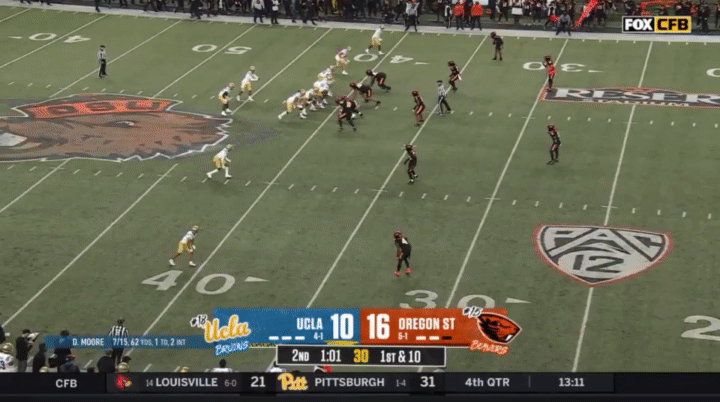
(Probably need to save this for the receiver section, but Sturdivant is lacking urgency on this route and needs to make a much sharper break than this rounded-out route.)
The following is a good defensive play, but it’s the sort of thing that results from deciding where to go with the ball pre-snap:
And again, on the opening play of the game, Moore stares down his receiver and fails to see the linebacker sitting there:

And yet another example of Moore staring down Sturdivant, which results in another interception:
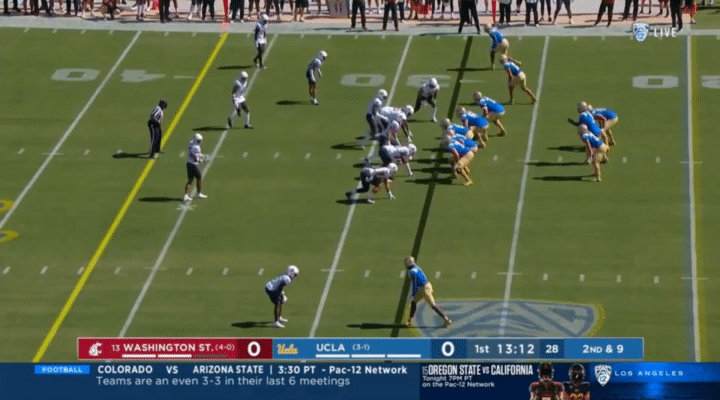
Some growing pains are to be expected, but in the rare case he doesn’t stare his receiver down, he still struggled with even basic passing concepts:
Usually freshmen quarterbacks like this compensate for their passing deficiencies with pure athleticism (the way previous UCLA QB Dorian Thompson-Robinson did, for example), but even his off-schedule plays are not great:

Although Moore is decently mobile in the pocket, he’s definitely not a dual-threat quarterback:
I’m sure there are plenty of teams that would love Moore’s raw talent, so I hope Moore eventually transfers to a place where he can develop his skills. The DJ Uiagalelei story arc, so to speak.
Running back
As a result of UCLA’s quarterback deficiencies and UCLA’s relative strengths along the lines, UCLA will look to establish the run game early, and later use play-action and the threat of the run game to open up passing lanes later on. UCLA’s best running back is TJ Harden, a strong, powerful runner with speed that belies his size. Most recently, Harden ran for 142 yards against USC, which is the most yards accumulated against USC by anyone not named Jaydn Ott (it’s roughly 88.75% of an Ott, which is obviously very good).
Harden doesn’t have elite speed, but he’s fast enough to pick up big yards when he gets to the second level:
He has enough speed to punish safeties that are out of position:
Harden has good vision, and does a nice job of finding his lane as he lets blocks develop:
Harden is also elusive in open space. Here he cuts so hard that the Stanford safety whiffs on the tackle entirely:
And here’s a clip which showcases all of his skills in one run: he’s patient to let his blocks develop, he finds the open lane, he uses his speed to get to the next level, and then he changes direction to make tacklers miss on his way to the endzone:
On the other hand, the running back you’ve probably heard the most about is Ball State transfer Carson Steele, an extremely hyped transfer (with some national media outlets referring to him as a “football freak [athlete]”—per the article, “He benches 405 and squats 615 and has just 7 percent body fat”). Steele led the Mid-American Conference in rushing yards last year, by being bigger and more physically imposing in the smaller conference. More importantly, Carson Steele has a pet alligator named Crocky-J (a Christmas present from Santa), so he oozes Florida Man energy despite his rural Indiana upbringing.
Despite all this… I just don’t get the hype. If anything, I’m more upset that Isaiah Ifanse didn’t receive a fraction of the Steele fanfare, considering Ifanse runs with the same style but is better in pretty much every conceivable way. But this is LA we’re talking about, which embodies meaningless hype over substance any day of the week.
Steele has a large frame for a running back, and shows good balance to make sure he always falls forward on runs, as Steele looks to run through contact:
Steele is very clearly a power back, looking to run through tacklers and always keeping his legs churning forward:
Steele may be strong, but he isn’t a hugely evasive back in the open field:
On the other hand, Steele possesses average athleticism and less than ideal speed and agility. And despite his size and strength, Steele is a liability in pass protection, and tries to cut-block more than anything else (PFF grades Steele a 20.1 in pass blocking). Steele may be a fringe NFL candidate, if only for his ability to be an every-down back due to his ability to absorb punishment, although it’s less clear if his athleticism will translate at the next level.
Despite this, UCLA has given the bulk of the carries this season to Steele instead of Harden, despite Harden averaging more yards per carry and the same number of touchdowns as Steele despite fewer carries. I wonder why this could be? Is there something fundamentally different about the two players? Some people might be reading between the lines, but it’s important to note that the former Philadelphia Eagles running back under Chip Kelly, LeSean McCoy, made sure to let everyone know he definitely never called Chip Kelly a racist. So definitely don’t read between the lines here, Carson Steele just fits Chip Kelly’s scheme better; he fits into the physical mold of a big, physical running back that can run zone read and gap scheme runs… like, say, Brittain Brown did last year. Steele just happens to look like what Chip Kelly looks for in a running back. A total coincidence.
I wasn’t sure if this last player fit into this section, but there is also the hybrid WR/RB Keegan Jones, who often lines up as a slot receiver (to be used in jet motions, short throws to the flat, etc) but also lines up in the backfield as an RB roughly one-third of the time. Jones is probably the only player to line up at running back for UCLA this season weighing less than 200 lbs., and is obviously the speediest, shiftiest player out of the backfield (and hence is used sparingly).
Here he receives the option pitch from QB Collin Schlee:
The next play is technically a pass, but the throw into the flat is clearly an extension of the UCLA run game:
I clipped the following play too early (force of habit to cut down on these file sizes), but Jones motions from the slot into the backfield to take the handoff, with RB Carson Steele functioning as a lead blocker. Jones shows that he actually is faster than the other players on the field:
UCLA likes plays like the one above, and will sometimes line up 2 or even 3 RBs in the backfield (or 2 RBs and QB Collin Schlee), stack them on a route out of the backfield, and have the front back either lead blocking for a run or catching a pass if no one engages them.
Receivers
UCLA’s most productive receiver this year is not a name I imagine many saw coming: WR Logan Loya, who was the 6th-most productive pass-catcher last season. To be fair, the receiver stats roughly correlate with the changing of starting quarterbacks, and Loya just happens to be QB Ethan Garbers’s favorite target, and Garbers just happens to be the only competent passer to play QB for UCLA this season.
It’s clear that Garbers and Loya have chemistry, and I am including the following play from the previous game (even though I wouldn’t normally save this to my highlights) simply because it’s representative of a play I saw so often. Here Garbers hits Loya on the short out route, and he’ll do it again a few plays later on the same drive in a similar situation (I think on a 3rd and 4, if memory serves) against man coverage. Both times, USC knew what to expect, but both times, USC couldn’t stop it:
To be perfectly frank, Loya simply hasn’t put out that much remarkable tape, and certainly not what you’d expect from a #1 WR with almost twice as many catches as the next leading receiver. He’s an average receiver. He lines up in the slot and catches a lot of short passes. That makes you the most productive receiver in this UCLA offense. Here Loya makes a nice adjustment to an off-target throw:
The following was probably the only real highlight I took of Loya, where he somehow makes a one-handed catch and taps his back foot in bounds to complete the catch.
Despite this, I wouldn’t say that Loya has a big catch radius (he doesn’t), nor is a reliable pass-catcher (he has his fair share of drops). His best attribute is his route running, and his ability to quickly get a bit of separation on short routes allows him to make those short catches and accumulate yardage.
Now, the guy who probably should be the #1 receiver should look very familiar to Cal fans: it’s former Cal WR J. Michael Sturdivant. I respect JMike and so I’m going to do the following breakdown as respectfully as I can, but to be perfectly honest, it’s quite frustrating to watch UCLA squander his talent. It’s like watching some out-of-touch rich guy who inherited his money purchase a Ferrari for his 16 year old nephew just so that the kid could drive the car straight into a goddamn wall because he forgot what the letters “R” and “D” stood for. YOU DON’T DESERVE TO HAVE A NICE CAR, YOU LITTLE SHIT.
J. Michael Sturdivant is an NFL talent. Period. I said it last year when he was a freshman, and I’ll say it again now. I would guess he gets drafted somewhere in the middle rounds, but as someone who wants to root for JMike (despite the disgusting baby blue jersey color he’s wearing), it has been painful to watch his regression this season. He has prototypical NFL attributes, but whoever has been coaching him needs to be fired immediately. I’m actually going to be hampered in this preview due to the fact that I don’t self-scout Cal, and so I don’t have Cal clips from last season that I can use to demonstrate my points that Sturdivant is an NFL talent. That’s how bad he’s been for UCLA this year.
Sturdivant is a long, rangy receiver with an exceptional catch radius. He’s not an explosive accelerator, but he has the straight-line speed to be a deep threat:
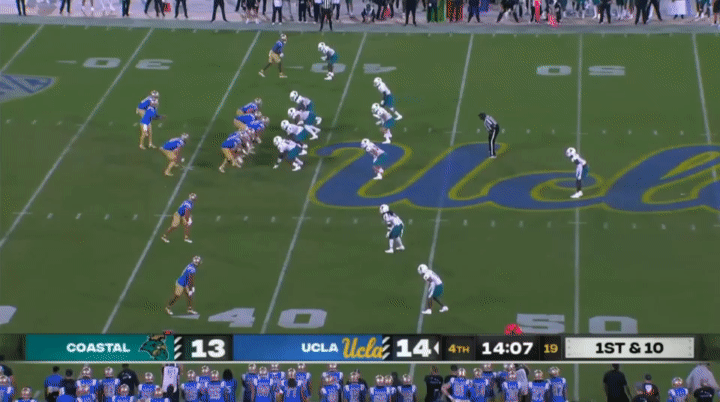
His deep threat ability alone necessitates special attention from the defense, and even though he hasn’t been especially productive this season, you definitely can’t neglect Sturdivant in coverage.
Sturdivant has the size, speed, and length which should make him difficult to cover, but he has a tendency to run lazy routes (you can see one such example in the Dante Moore section earlier), not showing urgency or selling his routes, and often making slow and rounded breaks on these routes. As a result, he struggles to get separation even from average college-level DBs, and he frequently finds himself blanketed by smaller corners:
At Cal, Sturdivant made good adjustments to the ball in the air. In the following play, he correctly leaves space between him and the sideline on the route, and Dollar Tree Garbers puts the ball in a great spot for Sturdivant, but he is still not in position for the throw. It’s just another example of his regression this year:
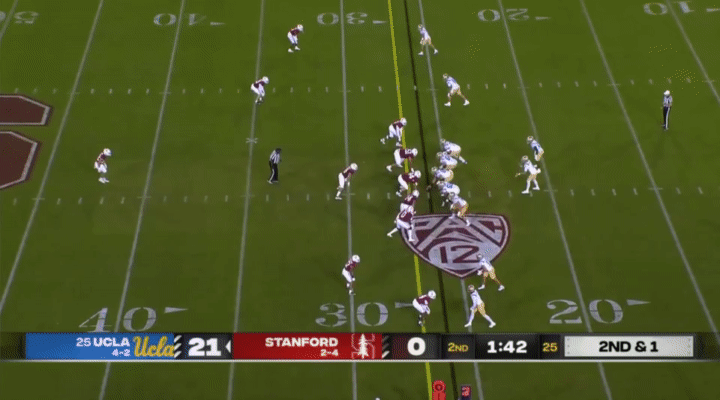
A continuing issue for Sturdivant is that he often makes concentration drops on uncontested catches (and also how I realized that PFF drop stats are not accurate, because PFF doesn’t consider the following play a drop):
Here’s another example where Sturdivant doesn’t use the physical tools he has to make this catch; another example I would blame on poor coaching. He again struggles to get separation on his route, and then tries to make the catch with his chest, instead of using his long arms and strong hands to make this catch away from his body and away from the defender. By trying to make this catch with his chest, he allows the defender to stick an arm in and break up the pass:
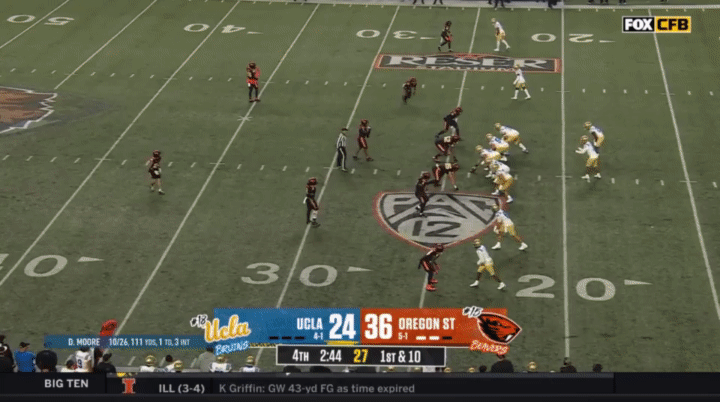
Despite his NFL attributes, his poor route running leaves him blanketed in coverage, and his poor catch technique means his contested catch numbers aren’t anywhere near where they should be for someone of his size and athleticism. He can be coached to run better routes. He can be coached to make contested catches. He can be coached not to drop easy passes. So why isn’t he? Fire that coach. I’ve never seen such an egregious waste of talent before. If Sturdivant wanted competent QB play and good coaching to impress NFL scouts, whoever is whispering in his ear needs to stop whispering nonsense and start telling him the truth. Sturdivant has 29 catches on 60 targets, meaning that he’s making a catch less than half the time. He had 65 catches on 102 targets last year as a freshman at Cal. That’s a painful regression, and if this keeps up at UCLA, his NFL hopes will be in spite of his play at UCLA and not because of it.
Back to the subject at hand, UCLA will find ways to get TE Moliki Matavao involved in the passing game, usually by using him to run block often before eventually having him leak out into open space to be a big pass-catching target. Here’s the same passing concept we saw on an earlier Garbers throw, and although OSU unsurprisingly defends it better than Colorado did, Matavao gets open and bounces off a tackle to pick up a couple extra yards:
Here Matavao leaks out, but still makes a nice catch in traffic even though Wazzu does a relatively good job of defending the pass:
Matavao shows good hands, but overall he’s a well-rounded tight end:
Behind Matavao is another big pass-catcher, TE Carsen Ryan. The official UCLA roster lists him as an RB, but he almost always lines up as a receiver (inline or in the slot) and rarely ever in the backfield, except in weird circumstances where he’s a fullback or halfback in some old-fashioned scheme. Here Ryan shows off an adept ability to shove off a defender, acutely aware of the apparent reluctance to call PI this year by the Pac-12 refs:
One player that I thought would be having a bigger impact this year is the walk-on tight end, Hudson Habermehl. The rangy 6’7” former basketball star shows some natural receiving ability and athleticism after the catch:
The next play is less of a highlight by WR Josiah Norwood and more so emblematic of the UCLA offense, in which the defense keys in on the UCLA run game, and UCLA takes advantage of that with play-action to hit a receiver behind the defense:

It’s much harder to pick clips to demonstrate this, but I think a critical factor in stopping the UCLA pass game will be how well the Cal defense can get off blocks by these receivers downfield, and if they can stay disciplined when UCLA finally uses the blockers in a passing capacity.
Conclusion
Although I respect QB Ethan Garbers (at least as much as you can respect someone attending the academic equivalent of a JUCO that has mistaken itself for an Ivy), the main purpose of the UCLA offense is to slowly churn points and eat clock while the UCLA defense creates absolute havoc on the other side of the ball. UCLA’s offense is going to run the ball for a few yards at a time and drive all the way down the field, kick field goals, occasionally score a touchdown, while the defense generates turnovers and short fields for the offense. UCLA is one of the worst redzone teams in the country—2nd worst in the entire FBS—scoring an abysmal 66.0% of the time in the redzone (26 TDs and 7 FGs on 50 trips). Cal isn’t all that much better in the redzone, but they are at least 10th in the Pac-12 with 78.3% scoring (31 TDs and 5 FGs on 46 trips) for comparison. However, the real story will be how the Cal offense fares against an elite UCLA defense—the best in the Pac-12 and one of the best in the nation, because of course “offensive genius” Chip Kelly has a mediocre offense and a top-tier defense. UCLA has elite NFL talent along the defensive line, from the nigh-unblockable Laiatu Latu (3rd in the FBS in sacks), to the emotional cheapshot artists physical Murphy twins. These players allow UCLA to generate significant pressure rushing just 3 or 4 players, compensating for a mediocre pass defense bolstered by the resulting additional players who can drop into zone coverage. Fernando Mendoza is going to be under constant pressure, he’s going to get hit, and he’s likely going to have to throw into spots where there are more defenders than receivers. Jaydn Ott will be running against a buzzsaw of a defensive line (2nd in the FBS, allowing just 62.1 rushing yards/game), one that doesn’t give up big runs. The offense will have a very tough task on Saturday, and I am hoping Jake Spavital schemes up some wizardry to deal with it.
See you never, UCLA.


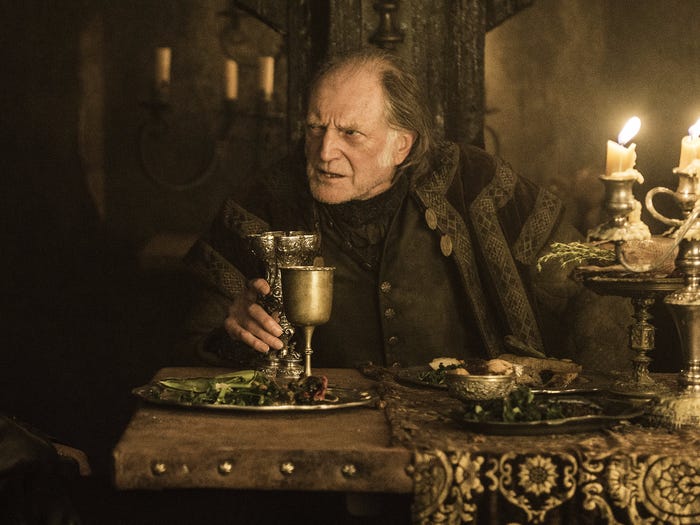

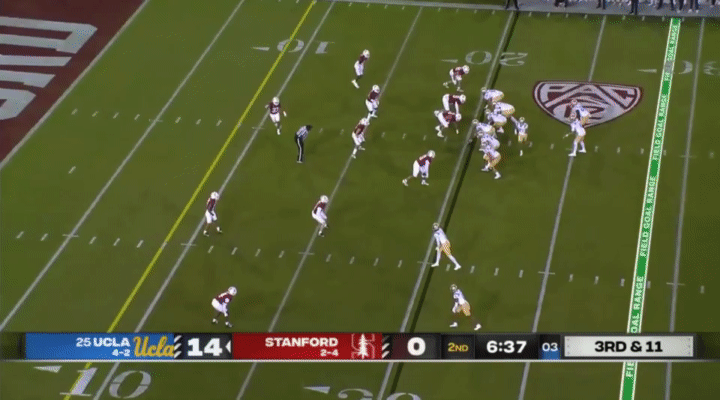




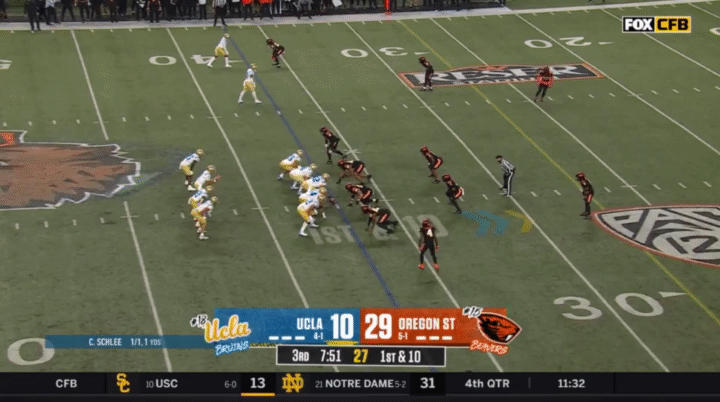

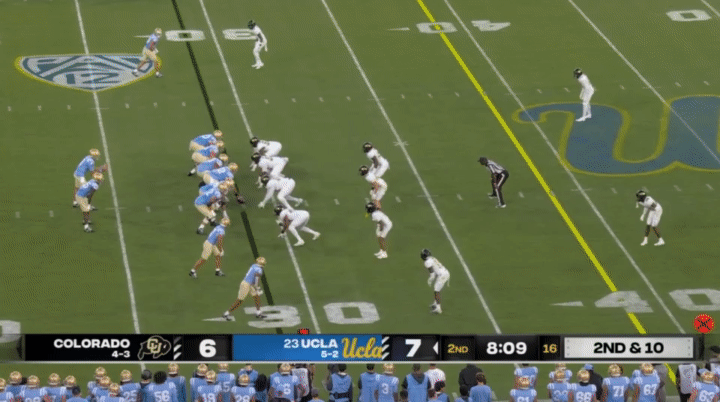




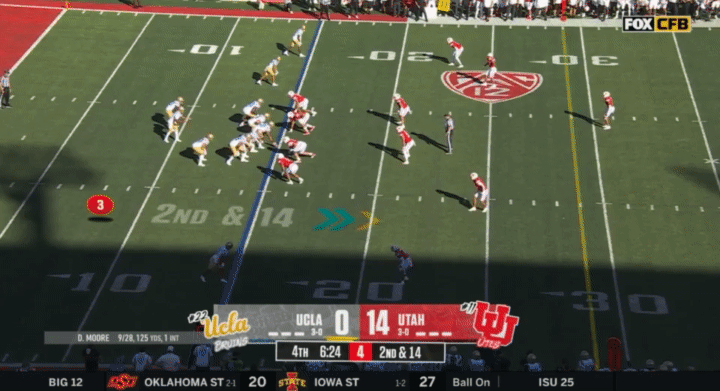


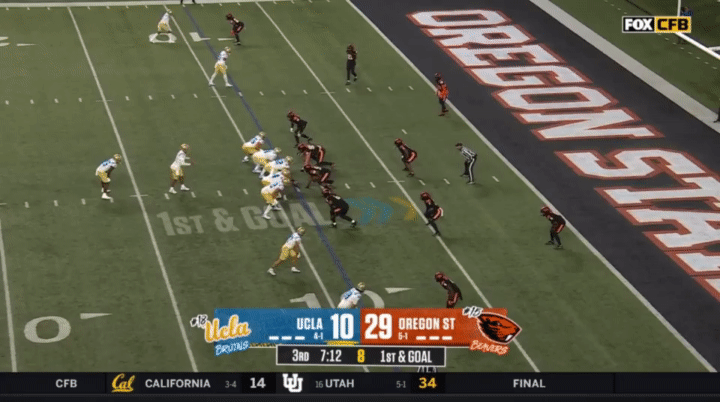
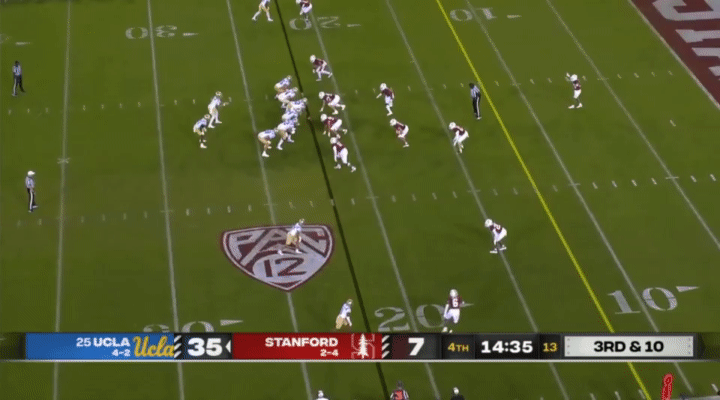
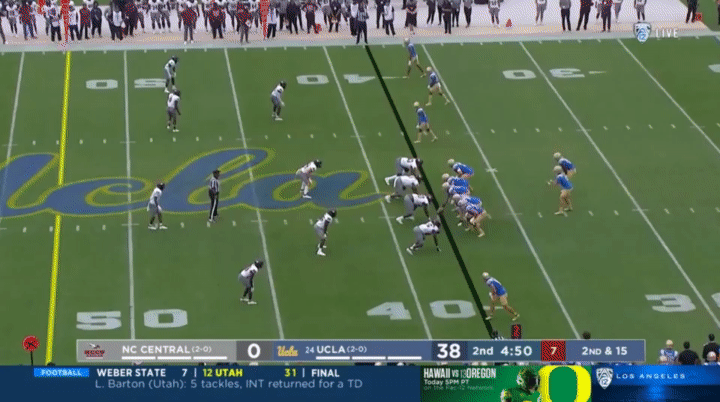

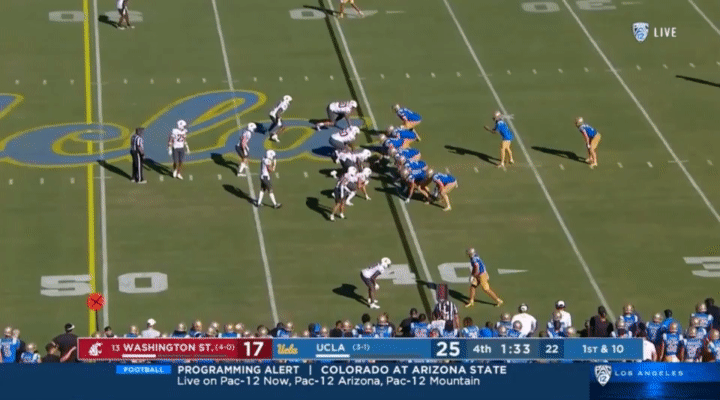

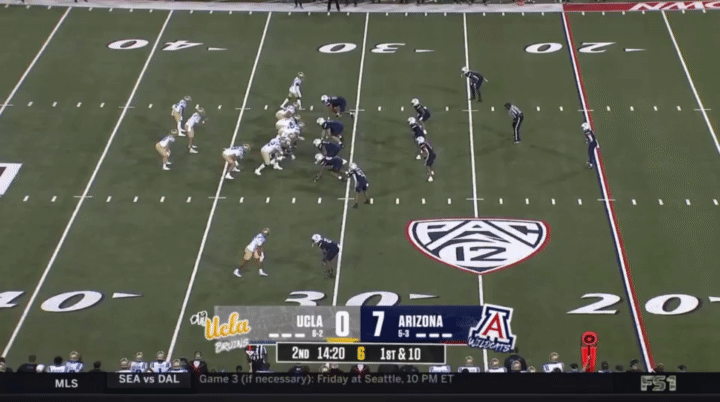
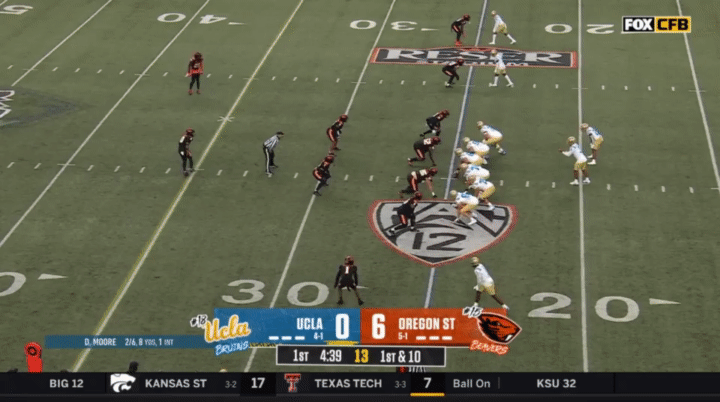
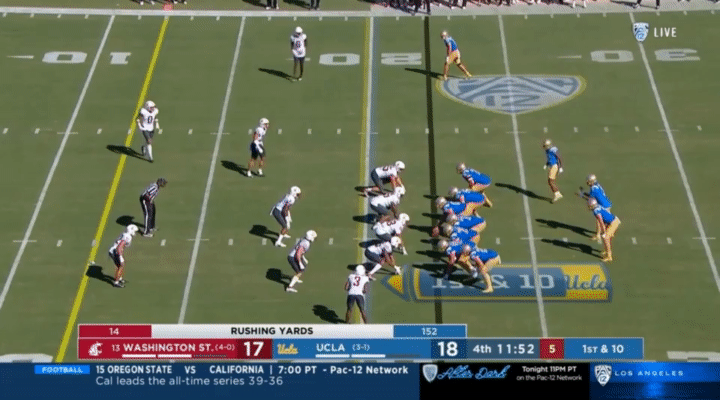

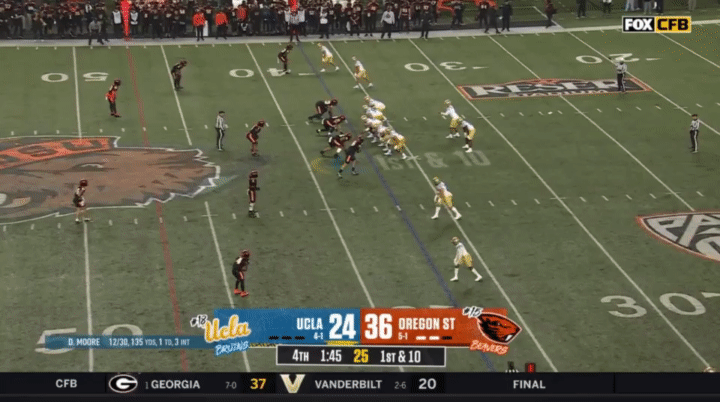

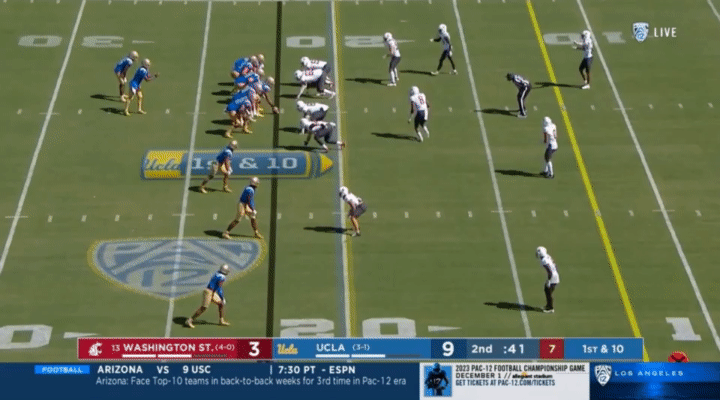
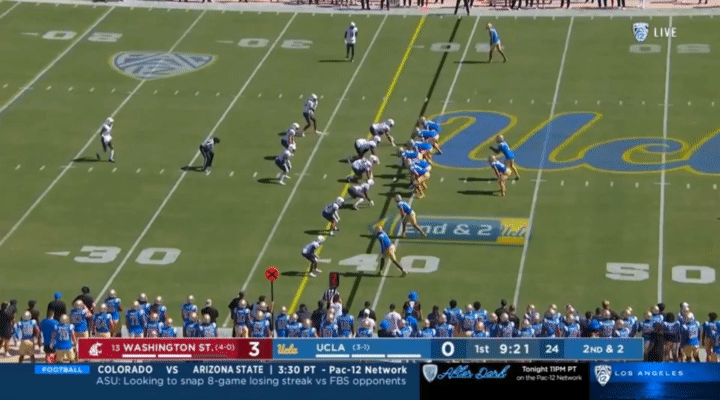



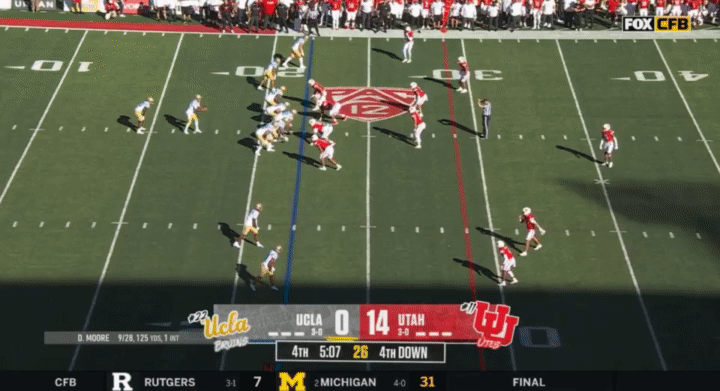
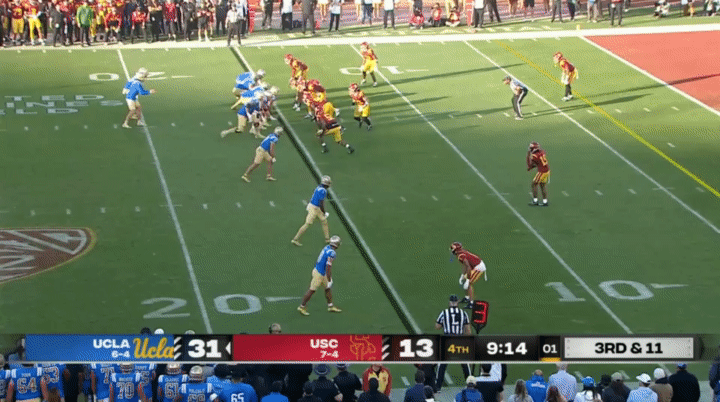
Ded.
Turning a blind eye to the moronic subhed, I hope the writer feels as good after the game as he does after this obvious self-therapy piece. It’s funny in parts, objectively informative in parts, and dripping with a lot of broad-brush personal hurt and resentment against an accredited institution that feels no pain.